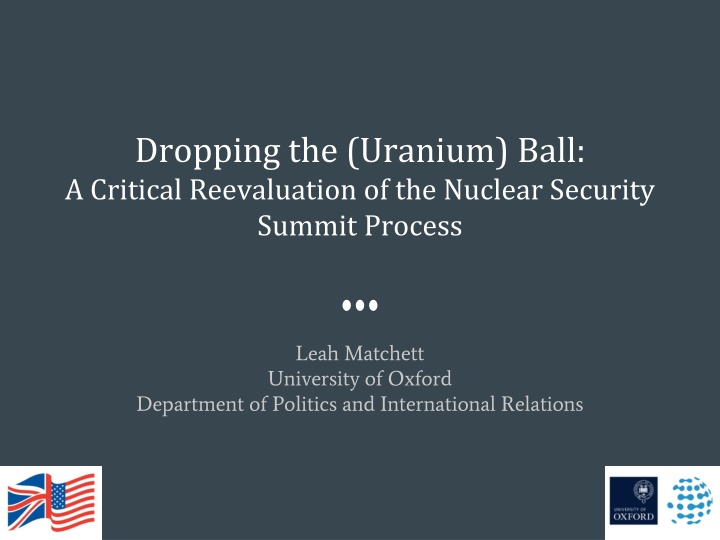
Reevaluating Nuclear Security Summit Issues
Explore a critical reevaluation of the Nuclear Security Summit process, including methodology, findings on positive and negative issue linkage, and the tension between universality and consensus. Learn about policy recommendations and insights derived from interviews and documents.
Download Presentation

Please find below an Image/Link to download the presentation.
The content on the website is provided AS IS for your information and personal use only. It may not be sold, licensed, or shared on other websites without obtaining consent from the author. If you encounter any issues during the download, it is possible that the publisher has removed the file from their server.
You are allowed to download the files provided on this website for personal or commercial use, subject to the condition that they are used lawfully. All files are the property of their respective owners.
The content on the website is provided AS IS for your information and personal use only. It may not be sold, licensed, or shared on other websites without obtaining consent from the author.
E N D
Presentation Transcript
Dropping the (Uranium) Ball: A Critical Reevaluation of the Nuclear Security Summit Process Leah Matchett University of Oxford Department of Politics and International Relations
Overview The Topography of a Summit Methodology Findings: Positive and Negative Issue Linkage The Tension between Universality and Consensus Policy Recommendations
Because this threat will be lasting, we should come together to turn efforts such as the Proliferation Security Initiative and the Global Initiative to Combat Nuclear Terrorism into durable international institutions. And we should start by having a Global Summit on Nuclear Security that the United States will host within the next year. ~President Obama, 2009
The Topography of a Summit There was just no appetite... for some kind of new treaty regime or some inspection mechanism to ensure the counties were complying with their various commitments ~Gary Samore Minilateral or Multilateral? This creates a tension between universality and consensus that runs through the entirety of the NSS process and its aftermath
Methods and Findings Data from 17 Interviews from 10 countries, cables and released documents Key Findings: Positive and Negative Issue Linkage: Elevating nuclear security to a summit level pushed the issue forwards but also led to linkages with other nuclear issues Tension between Universality and Consensus: How the limited invitation list has impacted progress on nuclear security as an issue both during and after the Summits
Positive and Negative Issue-Linkages Positive Issue- Linkages - Strong Bilateral Ties with the US lead to strong engagement with the Summits Negative Issue-Linkages - Weak Bilateral Ties with the US lead to to poor engagement with the Summits Links to other Nuclear Issues: Disarmament, Nuclear Safety, etc. become the most contentious part of the negotiation of the Summit Communiques -
Tension between Universality and Consensus The US stresses that it seeks a representative group of states, without clarifying why one state is included or excluded. The resentment among those states not included comes at a real cost to the later attempts to expand the achievements of the summit. - Expansion of the IAEA INFCRIC/869 is limited; December 2016 IAEA Ministerial Statement is weak
Policy Recommendations 1. The tension between universality and consensus should be tackled explicitly: getting caught in the middle sacrifices both universality and consensus. 1. Increased diversity of summit leadership would encourage a broader and more sustainable agenda a. This includes both non-US allies (Russia) and countries traditionally sidelined in nuclear debates (NAM)






















